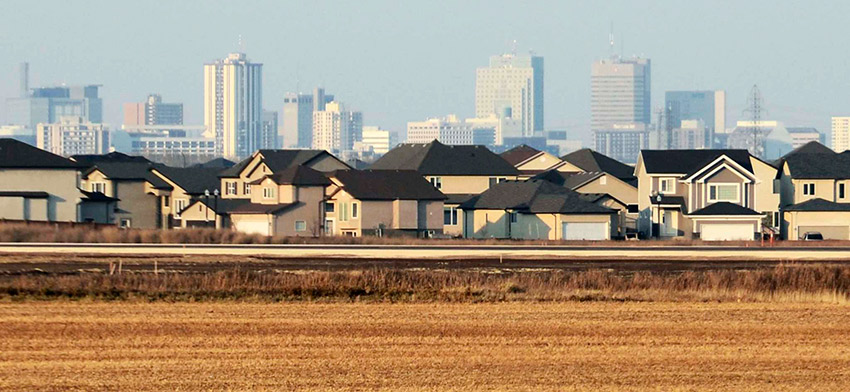
By Brent Bellamy, Creative Director and Architect
Republished with permission courtesy of the Winnipeg Free Press.
The recent release of Canada’s 2016 census was like catnip for us statistics nerds. Across the country, we slouched at our computers into the early hours, poring over everything from aggregate dissemination areas to census agglomerations. Image: (Brent Bellamy) The capital region’s sprawling growth is encroaching on important farmland and affecting other natural resources.
Image: (Brent Bellamy) The capital region’s sprawling growth is encroaching on important farmland and affecting other natural resources.
The census revealed that Winnipeg is growing faster than it has since the 1960s. After entering this century at No. 9, it is poised to soon retake the position of seventh-largest city in the country. Some visible trends were confirmed: mature neighbourhood populations have generally stayed level, the downtown population is growing and the city’s southern suburbs are booming.
Municipalities surrounding Winnipeg have continued to grow faster than the city itself, with Ritchot, Macdonald and Headingley experiencing a growth rate more than double that of the city and province.
The growth of these municipalities has been concentrated overwhelmingly in existing population centres. Many satellite towns are now ringed with suburb-style, low-density subdivisions and are beginning to experience the economic challenges with growth and municipal services with which Winnipeg is currently wrestling.
Presently, Winnipeg and each surrounding municipality work independently to resolve their growth issues, through nine individual and unco-ordinated development plans within the capital region. Resources and information are generally not shared across municipal lines and local decision-making is rarely evaluated against goals for the greater region.
This lack of a broad, collective vision led the Partnership of the Manitoba Capital Region (PMCR) to bring municipal leadership together and begin looking for a new way forward. On March 9, a capital region growth strategy will be unveiled, the result of a two-year collaborative effort among the 18 capital region municipalities. The action plan evaluates the district’s status and proposes concrete steps to establish a co-ordinated regional planning strategy.
According to PMCR, the capital region represents only 1.2 per cent of Manitoba’s land area, but is home to almost two-thirds of its population. It accounts for more than 70 per cent of the province’s GDP and, with 3,000 farms, represents 15 per cent of its agricultural production. The regional plan looks to establish an integrated and collaborative approach to growth in this important area of the province, leveraging the collective resources of each municipality and guiding decision-making over the long term.
The growth strategy defines shared objectives and breaks them down into five key strategic pillars, under the umbrella of a new framework for governance and implementation:
• Pillar No. 1: Co-ordinated regional development — Since 1971, the population of the capital region has grown by about 30 per cent, while the built-up land area has increased by 71 per cent, consuming more than 300 square kilometres of natural and arable land. The plan identifies the need to co-ordinate where and how development occurs through the creation of a land-use master plan, setting density goals and co-ordinating regional growth patterns.
• Pillar No. 2: Stewardship of land, water and resources — The health of natural resources, lakes and waterways is seen as critical to the region’s future prosperity. The plan establishes goals for a co-ordinated approach to environmental and resource management.
• Pillar No. 3: Strategic transportation networks — The strategy focuses on the need to co-ordinate regional transportation efficiently, addressing the movement of goods, community connectivity and public transportation, as well as pedestrian and cycling networks.
• Pillar No. 4: Infrastructure and delivery service — Co-ordinating emergency services, utilities, recreational facilities, landfill and recycling programs is promoted as an important way to find municipal and provincial budget efficiencies and improve the overall quality of life.
• Pillar No. 5: Economic development — The overarching goal for a regional growth strategy is to unite the capital district and encourage collaborative thinking that leverages the unique strengths of each municipality to grow economic opportunity, employment and tourism on a national and international level.
Each one of these pillars represents a big-picture challenge to Manitoba’s capital region. The leaders of each municipality came together, committed to the understanding that the solutions to these issues can be found only by working as partners through long term, collaborative planning.
A regional growth strategy is only the start of a long journey to build a cohesive vision for the economic engine of the province.
The unprecedented growth of Winnipeg and its surrounding municipalities, highlighted in the 2016 census, underlines that the time is right to commit to moving forward a planning strategy. Sharing resources and finding regional efficiencies for utilities, infrastructure and service delivery, through an inclusive planning process, could be an important strategy to help the provincial government achieve its goals of reduced budgetary spending.
A capital region growth strategy for Manitoba should establish a framework for a sustainable and prosperous future. Its implementation would allow us to leverage our advantages and improve our competitiveness with other Canadian cities — such as Calgary and Edmonton — that already have these structures in place.
There are many great plans collecting dust on the shelves of government. The potential of this strategy will only be realized with the provincial government as a fully committed partner, empowering the plan through funding and legislation and even broadening its scope with a new taxation model that supports sustainable growth patterns across the region.
With built-in accountability and strong commitment to a long-term vision, the future of Manitoba’s capital region could be a picture of dynamic, compact communities surrounded by healthy waterways and forests, and productive agricultural land anchored by a prosperous and vibrant capital city.
Brent Bellamy is creative director at Number Ten Architectural Group.
bbellamy@numberten.com